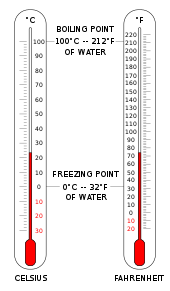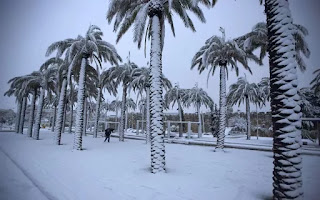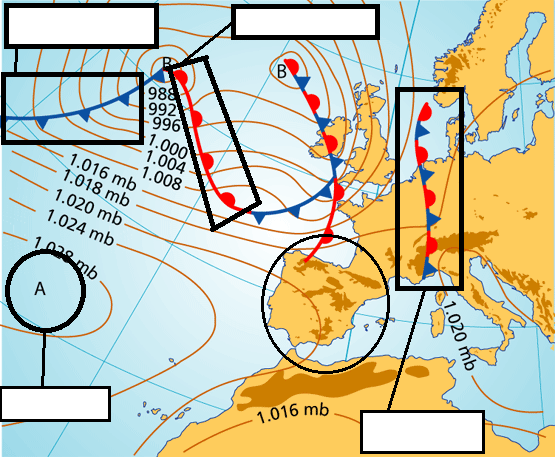THE ATMOSPHERE AND ITS CHANGES.
Functions and composition of the atmposphere.
Atmosphere: gaseous layer that surrounds the Earth.
Composition: is made up of water vapour and a mixture of gases:
- it provides gases that are essentials to life (oxygen).
- it filters dangerous solar radiation
- it regulates the planet's temperature.
- it protects the planet from the impact of meteorites.
 |
| In 1908 a meteorite was disintegrated by the Earth's atmosphere over Siberia. The explosion flattened 2.000 square kilometres of trees. |
The atmosphere's layers.
We can divide the atmosphere into five layers with different characteristics:
- Exosphere between 500 and 10.000 kilometres.Highest layer of the atmosphere. Its density is very low.
- Ionosphere, between 500 and 80 kilometres. Its high temperature (1500 deegres) causes meteorites to disintegrate.
- Mesosphere, between 80 and 50 kilometres. The coolest layer of the atmosphere (-90 deegres).
- Stratosphere, between 50 and 12 kilometres. It is contains the ozone layer that protects Earth from ultraviolet rays
- Troposphere, between 12 kilometres and Earth's surface. Its produces the planet's meteorological and climatic phenomena.
We have to distinguis between the atmospheric weather an the climate.
- Atmospheric weather is the state of the atmosphere over one place at a specific time. The weather is changeable and can be different every day. This is because the troposphere is divide into large air masses that are moving continuously over the Earth's surface.
- The climate is the average state of the atmosphere over one place during a long period ot time. It is calculated observing the succession of types of weather for at least thirty years. Is more stable than weather.
ACTIVITIES:
1. Indicate which of these phrases refers to weather and which to climate.a). The summers in Madrid are very hot and almost without precipitations.
b). The evening was cloudy and windy in London yesterday.
c). Weather is always hot and rainy in Indonesia.
d). This June has been hotter than usual in Seville.
e). They said that winters are very cold in Bergen.
f). Last week was raining all the time in Barcelone.
2. Match the definitions with the righ Word:
a). The layer in which take place the weather phenomena.
b). The hottest layer of the atmosphere.
c). The coldest layer of the atmosphere.
d). The last layer of the atmosphere, located at an altitude of between 500 and 10.000 kilometres.
e). The layer in which the ozone layer is located.
|
1.
Exosphere.
2.
Mesosphere.
3.
Ionosphere.
4. Trosposphere.
5.
Statosphere.
|
EXTERNAL LINKS:
ELEMENTS OF CLIMATE (I). TEMPERATURE AND PRECIPITATION.
The elements of climate.
Elements of climate: components of the atmosphere that can be measured. The main are:temperature, precipitation atmosheric pressure and wind.
Temperature and its factors.
Definition: temperature is the amount of heat in the air. It is measured in degrees Celsius (Cº), using a thermometer.
Temperature is determined by the following factors:
- Latitude. Between the Equator and the Tropics the temperature is always high because the rays of the Sun reach the Earth surface almost perpendicular, while in the Poles the solar rays reach the surface with an oblique angle.
- Altitude. The temperature drops 0.6ºC for every 100 metres above sea level, because the air is less dense and due to this conserves less heat.
- Distance from the sea. The sea waters change its temperature slower than the land, because of that temperatures are milder on the coast.Distance from the sea.
 |
| Madrid located 600 metres above sea leve. Medium average temperature in August is 26ºC. |
 |
| Navacerrada is a town, located near Madrid (50 km), but at an altitude of 1.200 metres above sea level. Medium average temperature in August is 16ºC. |
Also, we can distinguish different latitudinal thermal zones:
- One torrid zone, between the Equator and the Tropics.
- Two temperate zones, between the Tropics and the Polar Circles.
- Two frigid zones, around the Poles.
Isotherm: imaginary lines that connect locations with the same temperature in map.
Precipitation and its factors.
Precipitation: water that falls on the Earth's surface from the clouds, either in liquid (rain) or sold (snow and hail) forms.It is meassured with a pluviometer and it is calculated in milimetres (mm).
 |
| Pluviometer |
- Latitude. Precipitation levels are higher at the equator.
- Altitude and terrain. Precipitation levels rise in relation to increase of altitude.
- Distance from the sea. Precipitation levels are higher on the coast because the sea is a constant source of humidity.
 |
| Yakarta (Indonesia) located at a latitude of 4ºS has a precipitation level of about 1.800 mm, whereas Perth (Australia) located at a latitude of 31ºS has a precipitation level of 800 mm. |
 |
| As you can see in the image. The litoral zones of China recieve a far higher amount of precipitation than the interior zones. |
ELEMENTS OF CLIMATE (II). ATMOSPHERIC PRESSURE AND WIND.
Atmospheric pressure and its factors.
Definition.
Atmospheric pressure is the weight of a column of air on a place. It is meassured with a barometer and is expressed as millibars (mb).
The average atmospheric pressure meassured at sea level it is 1.013 mb, but the atmospheric pressure changes and it is higher or lower in different areas because of two factors:
- altitude, the higher the altitude, the smaller the volume and weight of the column of air over a location becomes.
- air temperature:
- cold air is denser and heavier, so its tends to fall. As a consequence, its warmed and produces dry and estable weather, and zones of high pressure known as anticyclones
- warm air is lighter and less dense, so it tends to rise, then cools and produces precipitation. As a consequence produces zones of low pressure known as depressions.
Weather maps.
A weather map is a chart that represent meteorological conditions over a
specific area at a specific time. In a weather map appear the following
elements:
- isobars, lines that connect all the points of equal atmospheric pressure.
- anticyclones are represented with a capital A (usually are also represented with an H, high pressure). The wind moves between the isobars from left to right in the northern hemisphere and from right to left in the southern hemisphere.
- depressions are represented with a capital B (usually are also represented with an L, low pressure). The wind moves between the isobars from rigth to left in the northern hemisphere and from left to right in the southern hemisphere.
- fronts, areas of contact between two air massess with different characteristics. Can be:
- hot fronts, represented with a red line with semicircles.
- cold fronts, represented with a blue line with triangles.
- Occluded front, represented with a red line with semicircles and triangles (is the meeting of a hot and a cold front). In this case, the front is about to dissapear.
 |
| Weather map. |
Wind and its factors.
Wind is the horizontal movement of air.
Measurement:
- its speed is measured in kilometres per hour (km/h) or in metres per second (m/s), using a anemometer.
- its direction is determined by the cardinal point of the source of the wind: east wind, north wind. Is measured using a weather vane.
 |
| Weather vane. |
On Earth we are going to find:
- constants winds that maintain an equilibrium of temperatures, transporting hot air towards the cold zones and vice versa. The most important are the trade winds (in spanish: alisios) which goes from the Tropics to the Equator, the west winds and the polar winds.
- seasonal winds, such as the monsoons (in spanish: monzones) in South East Asia
- daily winds, such as marine and mountains breezes (in spanish: brisas).
CLIMATES, VEGETATION AND BIOCLIMATES.
The climate and climatic zone.
The combination of the temperature, precipitation, amospheric pressure and wind creates the different climatic zones. A climatic zone
is a division of the climate of the Earth according to average
temperatures and average rainfall (precipitation level). We can
distinguish the following climatic zones:
- Torrid zone, which includes the equatorial and tropical climates.
- The northern and southern temperate zones, which includes the mediterranean, oceanic and continental climates.
- The northern and southern frigid zones which includes the polar climates.
Also appear azonal climates that can be found in different regions: deserts and mountains.
Vegetation and biosphere.
Vegetation: is the entire range of plant life in an área. It is a part of the biosphere.
Biosphere: is the combination of all living beings on the planet and the enviroment they live in. It is formed by the troposphere, the Hydrosphere and the litosphere. The main characteristic of the biosphere is its enormous diversity of plant and animal species (biodiversity). Plants are organised in vegetal formations.
A vegetal formation is the combination of plants in a región that are similar in size of characteristics. We can distinguish three types of vegetal formations:
- Forest areas are formed by trees. A tree is a plant which has a clearly defined trunk and is tall (usually more than 8 metres of height).
- Scrubland consist of bushes. Bushes are smaller than trees and have not trunk. Its branches divide at ground level.
- Grasslands consists of grasses.
 |
| Black Forest, Germany. |
 |
| Scrubland. Death Valley, California. |
 |
| Grasslands, Inner Mongolia. |

The distribution of the vegetation is conditioned by numerous factors:
- the relief
- the soil
- the climate (humidity, light, temperatura and wind).
The Earth's bioclimates.
Earth is divided in several bioclimatic enviorments or bioclimates. A bioclimate is a extensive región characterised by its own climatic features and vegetation. We can distinguish three major bioclimates:
- the torrid bioclimate.
- the temperate bioclimate.
- the frigid bioclimate.
ACTIVITES:
You can find the solutions here.
3. Identify the following elements in this weather map: anticyclones, depressions, isobars, fronts.
4. Identify the elements highlighted in the map and answer these questions:
a). How is going to be the weather in the zone surrounded by a circle: sunny, cloudy? Is going to rain? Explain why.
b) What does mean the numbers that appear in the lines of the map?
5. Review game.
With an A
|
A device use to measure the speed of the wind.
|
|
With a B
|
a extensive región characterised by its own
climatic features and vegetation.
|
|
With a C
|
science which study the various types of climate.
|
|
With a D
|
An area of low atmospheric pressure
|
|
With an E
|
vegetation (trees and shrubs) that retain their
leaves all the year around.
|
|
With an F
|
areas o contact between two air massess with
different characteristics
|
|
With a G
|
A vegetal fomartion composed of grass.
|
|
With a H
|
Area of contact between two air masses in which a depression advances
upon a anticyclone. It is represented with a red line with
semicircles.
|
|
With an I
|
lines that connect all the points with the same
temperature
|
|
With a I
|
A factor that explain why the average
temperature in the Alps is lower than in the Great European plain.
|
|
With an L
|
Factor that explain why the average annual temperature in Madrid is
higher than in London.
|
|
With a M
|
The coldest
layer of the atmosphere.
|
|
With an M
|
A seasonal wind typical of the South East of
Asia.
|
|
Contains a N
|
One of the layers of the atmosphere. It is the
hottest part of it.
|
|
With an O
|
A gas that protects Earth against the ultraviolet radiation from the Sun.
|
|
With a P
|
Fall of water from the clouds onto the Earth’s surface.
|
|
With an R
|
Precipitation in solid state.
|
|
Contains an S
|
Factor that explains why the average precipitation level in the interior
of the Peninsula Iberica is lower than in the coast.
|
|
With a T
|
The layer of the atmosphere located next to the Earth Surface. Is a part
of the biosphere
|
|
With a T
|
A climatic zone characterized by high
precipitation levels and high average temperatures.
|
|
Contains an X
|
The most exterior layer of the atmosphere.
|
|
With a Y
|
Imaginary lines that connect all the poinst with the same atmospheric
pressure.
|
|
With a W
|
Device use to determine the direction of the wind.
|
LINKS FOR THE POLLUTION PROJECT.
WATER OVERUSE:
SOURCES:
In spanish:
https://www.geografiainfinita.com/2016/05/la-historia-mas-triste-de-todos-los-mares-aral/
A brief history about the desaparition of the Aral Sea.
https://www.nationalgeographic.com.es/naturaleza/grandes-reportajes/ultrajes-al-mar-de-aral-2_9454/12
A lot of photographs about the disaster.
In english:
http://encyclopedia.kids.net.au/page/ar/Aral_Sea
A short article with data about the Surface and Depth of th lake.
AIR POLLUTION: CHERNOBYL AND FUKUSHIMA.
Sources:
In english:
Definition and causes of air pollution
https://kids.kiddle.co/Acid_rain
https://www.nationalgeographic.com/environment/global-warming/acid-rain/
https://wiki.kidzsearch.com/wiki/Acid_rain
http://www.coolfactsforkids.com/air-pollution-facts-for-kids/
HISTORY.
Before.
You can talk about the cities of Prypiat and Fukushima
before the two accidents. How big they were before the accident? How many
people lived there?
The catastrophe.
What happened in Chernobyl? And in Fukushima? What was the
cause of the catastrophe in Chernobyl? And in Fukushima? Was due natural
reasons? Or was due human actions? Was an accident?
CONSEQUENCES.
How many people died? There were any other consequences?
SOLUTIONS.
What do you think that can be done to reduce pollution? Do
you think that is posible? Why?
SOURCES:
In english:
https://wiki.kidzsearch.com/wiki/Chernobyl_disaster
A short article abut the Chernobyl disaster.
PLASTIC POLLUTION
In english:
https://www.ecowatch.com/22-facts-about-plastic-pollution-and-10-things-we-can-do-about-it-1881885971.html
In spanish:
https://www.salyroca.es/articulo/sal/isla-plastico/20161121170145002535.html
https://www.nationalgeographic.com.es/naturaleza/grandes-reportajes/ahogados-mar-plastico_12712
GLOBAL WARMING
In english:
SCHOOL'S ECOLOGICAL FOOTPRINT.
http://www.academickids.com/encyclopedia/index.php/Ecological_footprint
OZONE LAYER DEPLETION.
Try to answer the folowing quetions:
What is the ozone?
SOURCES:
In english
In spanish:














No hay comentarios:
Publicar un comentario